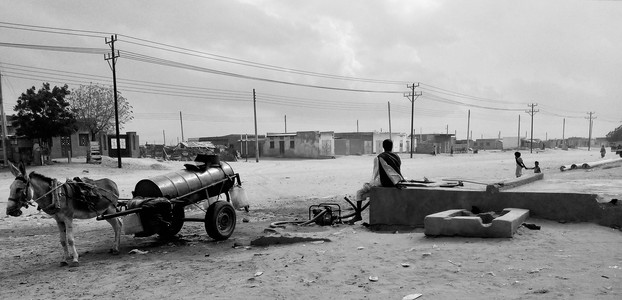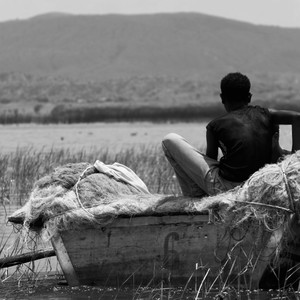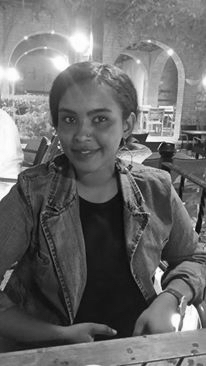A long-desired dreamCan the Nile River secure Port Sudan’s water supply?

Maaza Abdullah, lives in Port Sudan’s Umalgora, in Sudan’s Red Sea State. She says she would like to see the government provide “water security”. To her, this means providing clean water for all citizens so that she and others no longer have to struggle to find water.
Red Sea State has had a problem with its water supply for decades, and it’s a problem that countless state governments have failed to solve. The city of Port Sudan, in particular, has been affected by the issue. The situation became so critical that in 2013 the town suffered a severe water crisis, exacerbated by soaring temperatures.
However, new plans to revive a shelved project to convey water from the River Nile is offering some hope to the city. For now, Port Sudan residents rely on declining natural sources of water, or they buy commercial products.
The primary source of natural water is the Khor Arbaat Basin, which is supplied by a seasonal creek northwest of the city. They also access groundwater from several wells.
Constant challenges
“Since the 1960s, the water level in the lake started to decline because of the decreased rainfall ratio,” says Abdulrahim Awaad, director of planning and development at the State Water Corporation. “We were affected the most in 2013 when the city was hit by a severe crisis. The rest of time we have always faced challenges, though it remains manageable.”
We have always faced challenges, though it remains manageable.
While the city has continued to expand, its growing population has had to make do with the same, if not depleted sources of water.
One of the ways the state has sought to tackle this water scarcity is through seawater desalination. In 2003 it established four desalination plants, with a total capacity of 15,000 cubic meters a day. However, the economic sanctions against Sudan at the time meant the plants lacked spare parts, and they had to be shut down. Awaad said that a new plant with a 3,000 cubic meters production capacity was currently under construction.
Meanwhile, there are also a few private water treatment plants operating in the city, which use water from the wells or the Arbaat Basin. One of the companies, Tasneem, uses groundwater from a well that is located 5 kilometres outside the city.
“We do daily chemical analysis, and monthly microscopic checks to make sure the water is potable,” Nafisa Mahmoud, a chemical analyst at Tasneem said. “We use sand filters at the beginning, then inject the water with substances that balance the PH and eliminate planktons. Finally, we proceed filtering to reduce salinity.”
Many promises
According to Awaad, during the 2013 crisis, government officials, including the vice president, and international NGOs visited the city to try to tackle the issue. “Britain took an interest in our problem,” Awaad said. The British development ministry put forward a plan including measures covering “desalination plants, maintenance of water pipelines from Arbaat, maintenance of wells and local tanks, and replacing the intake from Arbaat with a stable one”.
The “Strategic Investment Program for Water and Development” only covered Port Sudan rather than the entire Red Sea State. The budget was US$ 200 million, with the British government providing US$ 10 million as well as technical support, capacity building programmes, and the institutional reform of the State Water Corporation. However, the plans have been stalled because the government did not fulfil its part of the agreement, Awaad says.
What is clear is that, despite ongoing official promises and plans, the people in the city have seen little progress. “We have a water pipeline from Arbaat in this area, but it’s semi-idle,” says Waleed Mohamed, a taxi driver who has lived in the Salalab-Port Sudan suburb since 1993. “It would work one or two days a week, in the summer it could stop for two weeks or work once weekly,” he said, explaining that he often buys water from the back of donkey carriages. “We wish the ‘long-desired’ Nile water would arrive here.”
Maaza Abdulah says that residents in her area get water from tanks fed by pipelines from Arbaat but the pipelines are not connected to the houses, and when there’s a shortage, she buys water instead. “I take water from private tanks in the neighbourhood. It’s not potable, and we have it for daily use, and we drink mineral water only.”
In winter the water is available most of the time, while in summer the tanks are empty for long periods and she is forced to buy water from donkey carriages. She complains about the quality of all these sources and says she would like to have access to potable water from pipelines that are adequately connected to the houses and work all the time.
Health impact of dirty water
There have been cases of diarrhoea in the city, which are suspected of being related to water quality. When contacted about the issue, the State Water Corporation said the cause was illegal wells drilled inside the city during the 2013 crisis, which had been polluted by the sewage. The utility claimed that the contaminated water was being sold to consumers from the back of trucks and donkey carriages. They denied any problems concerning Arbaat water.
However, a Health Ministry spokesperson stated that their investigation had found otherwise. “We found health problems in some water sources people use – we had to treat a lot of them with chlorine with the help of the Sudanese Red Crescent. It was main stations fed by the Arbaat. We make sure it’s all treated. And other pollution problems are caused by the unmonitored transportation.”
The Health Ministry said that the municipal authorities carried out regular inspections of all water sources, including tanks and pipelines all over the city. “We closed any affected wells, and we educated people about using chlorine, even private tanks fall within the scope of our inspections,” the ministry stated.
These private tanks are usually underground tanks managed by citizens to provide water for nearby houses via hoses – typically free of charge – and are used to fill the small barrels carried by donkeys. The tanks are to be found all over the city, and the water comes from the Arbaat.
“I’ve run this tank for 20 years now,” says Haj Alnoor, a tank owner in Umalgora. “We work daily unless there’s a shortage. It’s available in winter, not so much in the summertime. Most of the people use it directly, without treatment, for drinking or cooking.”
With most tank owners, the State Water Corporation and the Health Ministry have agreed on the regular inspections. These don’t cover the donkey-carriage operators or some independent tank owners. That is a problem, as in many places in the state the only source of water is the donkey carriages.
One such place is Ageeg, a village on the outskirts of the city. Osman – a fisherman who lives there – explains how the people of the village struggle to access water. They cannot use the seawater, are too far from the Arbaat, lack an appropriate dam to hold the seasonal water that comes down from mountains, and have no pipelines whatsoever. Instead, he explains, they are forced to buy water from donkey carriages when it’s available.
The long-desired dream
The head of the State Water Corporation, Naji Ezzuldeen, says that the Nile Water Project is considered “the ultimate solution for water issues in the city”.
We wish the long-desired Nile water would arrive here.
The plan is to construct a water supply system across the 470 kilometres that stretches from the Atbara area of the Nile River to Port Sudan.
The project goes back to 2003 when two consultancy firms drew up an initial plan. Then in 2006, a contract was signed with a Chinese company. “However nothing happened in this regard until the company withdrew in 2013 due to funding issues and other reasons,” Naji said, explaining that these included the sanctions against Sudan at the time.
“We started a partnership with the Giad company aiming to bring a Chinese company to execute the project and to come up with a suitable funding plan,” he said. “We had several meetings, and the work is ongoing. We expect to reach an agreement soon.”
Naji said that a number of international companies have made offers to be involved in the project since the United States lifted sanctions last October. He pointed to the fact that the project had been included in the federal budget for this year: “2018 will witness the start of this long-desired dream.”






